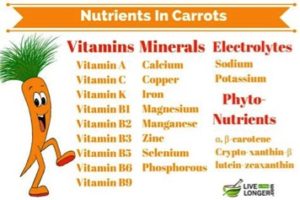The carrot is a crunchy, tasty, and highly nutritious vegetable. Like the potato, it grows underground and only its leaves are seen above the soil.
Carrots were first cultivated in the area that is now Afghanistan. They were mostly purple and skinny. They were also small and forked. They had a bitter, woody flavour.
In the sixteenth century, Dutch scientists bred the pale orange carrot, which is now found around the world. Dutch botanists also got rid of the bitter taste of the original wild carrot. Earlier, there may have been black and red carrots, too, but there were no orange and yellow carrots.
Carrots have beautiful, lacy white flowers. Carrot tea is made from dried carrot leaves. It is supposed to be a remedy for kidney stones.
Carrots are rich in vitamins, minerals, and fibre.
They are also a good source of antioxidants. Antioxidants are nutrients found in foods, especially vegetables, fruits, and berries. They help the body remove free radicals. Free radicals are compounds that are harmful if their levels become too high in your body. They are linked to multiple illnesses, including diabetes, heart disease, and cancer.
Carrots promote weight loss, lower cholesterol levels, and improve vision.
If you eat too many carrots, you might turn yellow, but the colour goes away after you stop eating this vegetable.
A. Find words that say the same thing. Different words that have the same or similar meaning are called synonyms.
Example: ‘Skinny’ can be substituted with ‘thin’. ‘Skinny’ and ‘thin’ are examples of synonyms.
Find a similar word in the text for:
1. Grew (past tense of ‘to grow’). Hint: ‘To breed’ is the present tense of this verb.
2. A scientist who studies plants
3. A native of the Netherlands
4. A cure
5. To make something better
6. Delicious
7. Connect
8. Assist
B. Fill in the blanks with words from the text.
1. The cabbage in the noodles should be slightly __, and not soft.
2. Whole wheat bread is more __ than white bread.
3. The ozone layer in the atmosphere filters out much of the __ radiation from the sun.
4. Ginger tea is a __ for a sore throat.
5. Spinach is __ in iron.
6. Limes, lemons, and oranges are a __ of vitamin C.
7. People in the eastern and southern parts of India mostly __ rice.
C. Did you know?
What do you call a scientist who studies stars, planets, galaxies, and outer space? An astronomer.
What do you call a scientist who studies animals? A zoologist.
What do you call a scientist who studies birds? An ornithologist.
D. Vegetable Rainbows
There are many coloured vegetables.
They are good for you.
Carrots are orange, let’s eat a few.
Beans are green, let’s try them, too.
Corn is yellow, tomatoes are red.
When you eat a rainbow,
You know you are well fed!
E. ‘The day is coming when a single carrot freshly observed will set off a revolution.” — Paul Cezanne
Paul Cezanne (1839–1906) was a very famous French painter. Here he is talking about the importance of close observation when painting an object, in this case a carrot. Even this humble vegetable deserves to be studied carefully by painters. If they pay attention to simple and ordinary things, they will bring about a major change in the world of art.

Revised July 2020
Audio courtesy Tara Kriplani:
